Unveiled August, 25, 1908, The Catherine Schuyler Chapter of the DAR dedicated a boulder and tablet marking the location where Moses Van Campen ran the gauntlet as a prisoner of the Seneca Indians.
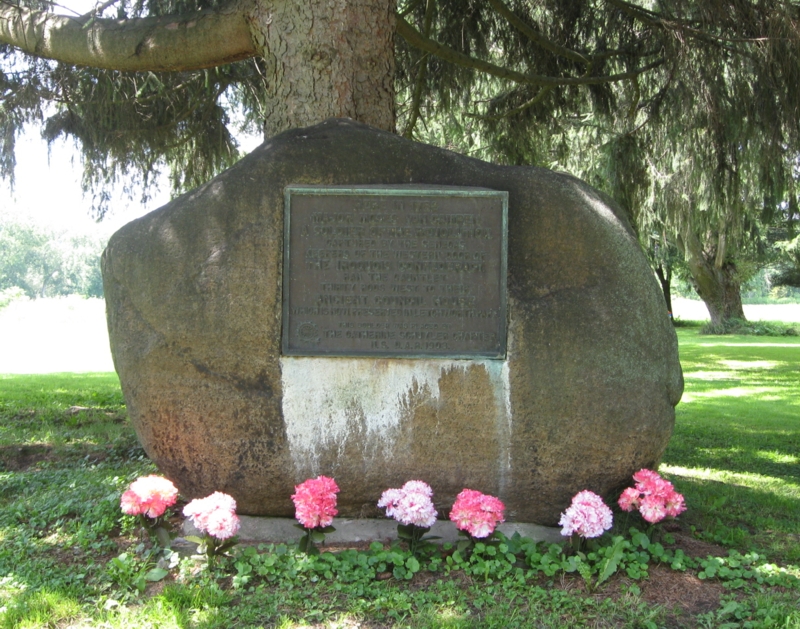 Boulder and tablet marking the location where Moses Van Campen ran the gauntlet as a prisoner of the Seneca Indians. Donated by the Catherine Schuyler Chapter of the DAR. Photo by D.C. Hopkins for MosesVanCampen.com
Boulder and tablet marking the location where Moses Van Campen ran the gauntlet as a prisoner of the Seneca Indians. Donated by the Catherine Schuyler Chapter of the DAR. Photo by D.C. Hopkins for MosesVanCampen.com
The plaque reads, "Here in 1782, Major Moses Van Campen, a soldier of the revolution, captured by the Seneca’s, keepers of the western door of the Iroquois confederacy, ran the gauntlet thirty rods west to their ancient Council House, which is now preserved in Letchworth Park. This boulder was placed by the Catherine Schuyler Chapter N.S. D.A.R. 1908."
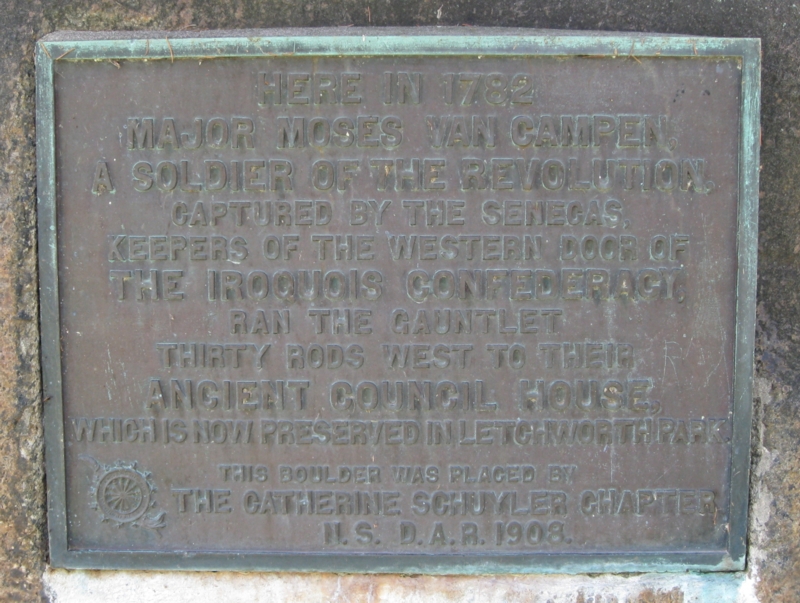 Detail of tablet marking the location where Moses Van Campen ran the gauntlet as a prisoner of the Seneca Indians. Donated by the Catherine Schuyler Chapter of the DAR. Photo by D.C. Hopkins for MosesVanCampen.com.
Detail of tablet marking the location where Moses Van Campen ran the gauntlet as a prisoner of the Seneca Indians. Donated by the Catherine Schuyler Chapter of the DAR. Photo by D.C. Hopkins for MosesVanCampen.com.
The September 3, 1908 issue of The Bolivar Breeze tells the story of its unveiling including John S. Minard's address. The article appears below in its entirety.

September 3, 1908
Bolivar, Allegany Co., N.Y.
_______
MIGHTY MAN WAS MOSES VAN CAMPEN
________
Revolutionary Hero, Indian Fighter, Daring Scout and Valiant Border Man. Ran Gauntlet at Caneadea.
_________
WAS ALLEGANY PIONEER
Interesting Sketch of His Life and Exploits Read by John S. Minard at Unveiling of Boulder Near Site of Council House, August 25.
Mr. Minard's Address.
Madame Regent and Ladies of the Catharine Schuyler Chapter, D. A. R.: With very becoming ceremony you have unveiled a boulder and tablet which will for long years to come mark the scene of an interesting and exciting experience in the career of a valiant border man, daring scout, and distinguished soldier of the American Revolution. And moreover, a man of much note as a civilian; one of the very few first of our country's pioneers; a surveyor of no mean ability, and extensive practice; one who as a member of our first court, charged our first two grand juries, and held important appointive and elective positions.
He was one of the six who founded the First Presbyterian church in the county and for some years was its ruling elder. His religion was of the practical, matter-of-fact, sturdy variety, so fittingly typified by this marker.
Ladies, in placing this monument, you pay handsome tribute to a worthy man, and perform an important patriotic service for which you richly deserve the lasting gratitude of the present, and the grateful remembrance of all future generations of Western New Yorkers.
I wish to congratulate you on the successful accomplishment of so worthy an object, and to say that I feel it a distinguished honor to be assigned so prominent a number in these exercises. I thank you for the compliment, and only hope the event may be such as to justify you in bestowing it.
Ladies and gentlemen, interest in this occasion is greatly intensified by the fact that the incident alluded to by the marker occurred, and we assembled at this moment, clearly within the limits of an ancient Indian village, which was one of the most important of the chief towns of the Senecas, the most powerful and warlike of the Six Nations which composed that wonderful "Iroquois Confederacy," or "League of the Iroquois," which has challenged the contention and won the admiration of historians, who have given its people post-humous fame, by calling them "The Romans of the West."
The power of the Confederacy was felt and dreaded from the Hudson to the Mississippi, and from the Great Lakes to the Gulf of Mexico.
At the beginning of the Revolution, Ga-o-za-de-o, where we now are, was, and for some time had been, the "Western Door'' of the "Long House" of the league. At this place their chiefs were required to reside.
Over the hills to the northwest ran a main trail through parts of Rushford, Centerville, Freedom, Arcade, and on to Buffalo Creek, and Fort Niagara. To the east ran the "Canisteo path," through Allen, Birdsall and Almond, to the head waters of the Susquehanna, while down the river a trail led to O-wa-is-ki, Gardean, Little Beardstown and Canawagus.
Up the river was a path leading to the divide between the waters of the Genesee and the Pennsylvania streams, and on and on.
With the exception of the Oneidas and part of the Tuscaroras, the Six Nations espoused the cause of Great Britain.
In this age of commercialism and, viewing the matter, with perspective of 130 years, we can hardly find It in our hearts to blame them, for it must be admitted that they had been well treated by Britain; better, quite likely, than the colonies could have afforded to do by them.
Very naturally It came about that Ga-o-za-de-o was a sort of a military post, a center from which operations proceeded, a rendezvous for recruits, a place of mobilization for descent upon the frontier towns of New York and Pennsylvania.
To this place for the purpose of co-operating with the Indians in organizing war parties, was sent Capt. Nellis of the historic "Butler's Rangers," and his son, who was a lieutenant.
Here an Indian, past middle age, who in his early manhood had assumed the name of a white friend called Hutson, but who come to be called Hudson, was living when hostilities began. He was the ranking chief there. Another chief here was Gah-nee-son-go, (man fond of nanniberrles), but who was better known as Shongo, or Col. or Capt. Shongo.
The two were great friends and had been from boyhood. They had often been on the path together, and were [illegible word] distinguished as warriors.
The exalted title of Dio-nee-ha-gaweh, "Open Door," was therefore given each of them, and they shared equally the honors and responsibilities of "Keeper of the Door."
These two chiefs in 1777 headed the party which captured Horatio Jones.
Close students of lndian-Revolutionary history aver that right here were matured the plans for, and the last council was held before the descent upon Wyoming.
Indeed, some claim that Shongo was in command of the Indian part of the expedition, which made such a black record for 1778. It is certain that the Caneadea Indians were there in force.
When in 1779, Sullivan's army was sent into the country of the Six Nations to punish the Indians, and lay waste their towns and cornfields, a young man barely 22 years of age accompanied the expedition in the capacity of quartermaster. His name was Moses Van Campen. At the battle of Newtown, near Elmira, the young quartermaster, though not required to, took part in the fray, and engaged with an Indian in a sort of a duel from behind trees. Succeeding in drawing the fire of the Indian without harm to himself, Van Campen had nothing more to fear from that particular tree, until the Indian could reload his piece, in doing which he exposed a part of his person, easily guessed by those familiar with old-time firelocks.
Drawing the sights close to the mark, Moses pulled the trigger. A wild shriek followed and Mr. Indian disappeared.
Some 40 years later Van Campen and Shongo met in a store in Angelica and soon engaged in relating their war exploits.
Van Campen related the incident at Newton, when to his surprise, Shongo exclaimed, "I same Indian, I same Indian," and to prove it, removed his breech cloth and showed the scar.
In 1780 Van Campen and others were captured at Shawnese Flats by a party of nine Indians from here, commanded by John Mohawk and his father and younger brother were killed.
In the night they effected their escape by killing all but the leader, who engaged with Van Campen in a terrific struggle, after the latter had killed five of them with his own hand, wielding a tomahawk which he had stolen from his adversary. Mohawk succeeded in getting away, but with a gash in his neck or left shoulder which it required several months spent here and at Fort Niagara to heal. He ever after carried his head to one side. I have met with several who have told me they had seen the scar.
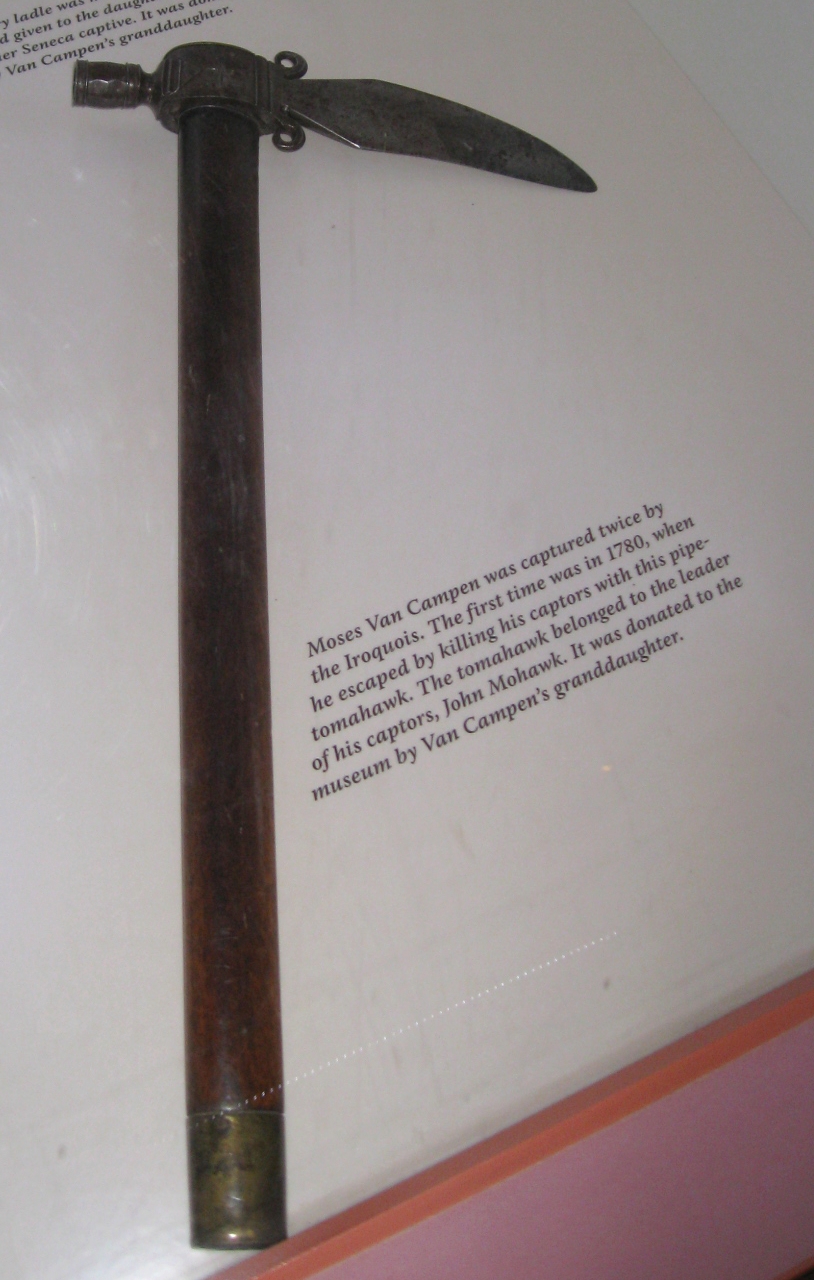 The tomahawk of John Mohawk, stolen and used by Moses Van Campen to kill several Indians, wound John Mohawk, and escape captivity April 2, 1780. On display in the William P. Letchworth Museum - Letchworth State Park, NY.The historic weapon used on that interesting occasion, is now to be seen in the Genesee Valley Museum in Letchworth Park.
The tomahawk of John Mohawk, stolen and used by Moses Van Campen to kill several Indians, wound John Mohawk, and escape captivity April 2, 1780. On display in the William P. Letchworth Museum - Letchworth State Park, NY.The historic weapon used on that interesting occasion, is now to be seen in the Genesee Valley Museum in Letchworth Park.
Long years after, when Van Campen was living in Dansville, Horatio Jones met Mohawk somewhere in that neighborhood, and persuaded the scarred old chief to visit his old-time adversary.
The chief first declined saying, “Van Campen will not want to see me." "Yes he will," said Jones. "Van Campen is a warrior. It is peace now. He will be glad to see you."
He went. It was just dusk and Van Campen was sick and in his bed. A daughter answered the call and told her father there was an Indian at the door who she thought was Mohawk. "Tell him to come in," said the Major. "But are you not afraid?" said the daughter. "No. Tell him to come in,” said the father. The Indian came in and they met in this way.
Said Van Campen, "Are you John Mohawk?" "Yes," said Mohawk. "Come here,” said the Major. He came to the bedside and Van Campen placing his hand on his neck and running it down under the clothing, felt the scar quite plainly, exclaiming; "Yes, you are John Mohawk. That's my mark."
A word as to Mohawk. It has been said he was the most humane of all the Caneadea warriors, and numerous instances to save the lives of prisoners, who otherwise would have been cruelly tortured or killed.
Mohawk carved a butter ladle and gave it to a daughter of Van Campen as a token of friendship. The ladle is in the museum at Glen Iris.
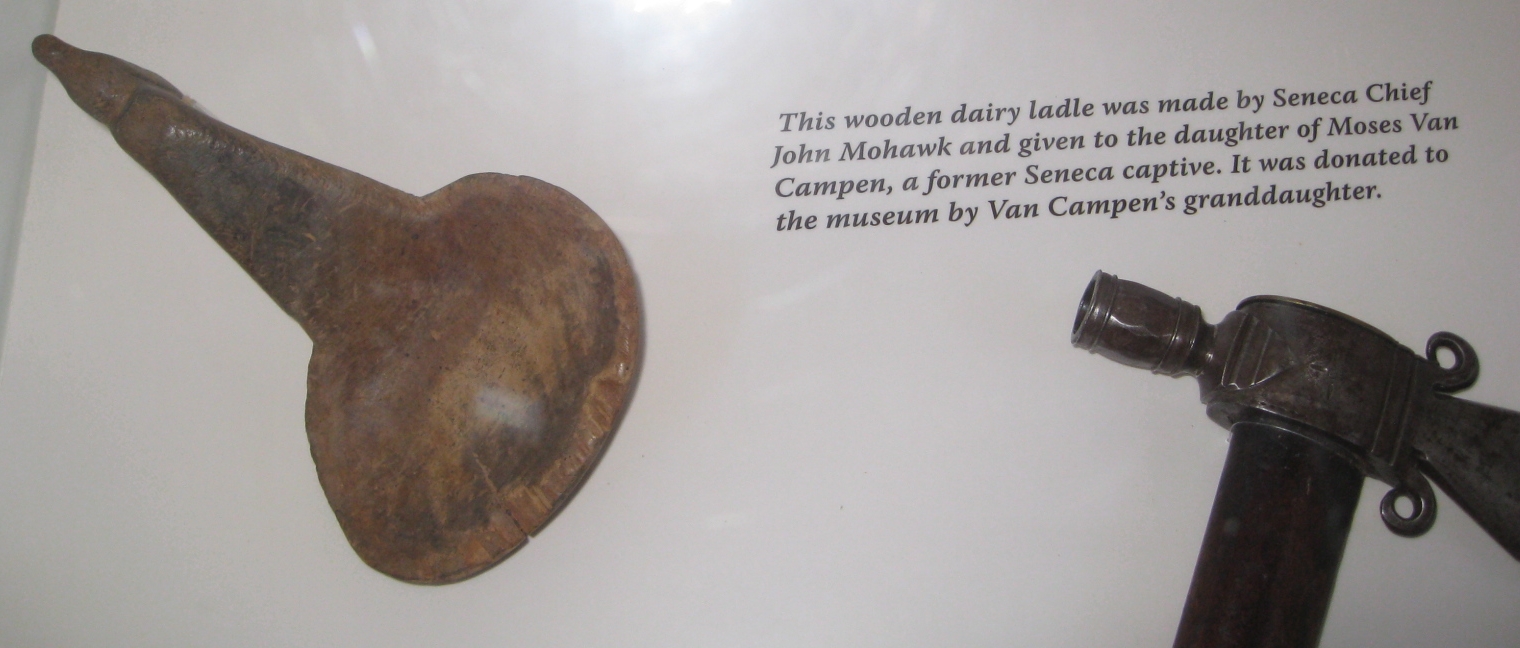 Butter ladle carved by John Mohawk given to a daughter of Moses Van Campen as a token of friendship. On display in the William P. Letchworth Museum - Letchworth State Park, NY.
Butter ladle carved by John Mohawk given to a daughter of Moses Van Campen as a token of friendship. On display in the William P. Letchworth Museum - Letchworth State Park, NY.
On the 16th of April, 1872, on Bald Eagle Creek, Pa, Van Campen with a company of 25 men was attached by 85 Indians under Hudson and Shongo, assisted by Lieut. Nellis and a platoon of Butler’s Rangers.
Nine of Van Campen’s men were killed, three escaped and the rest with Van Campen surrendered.
The party with their prisoners at once set out for this place. At the Pigeon Woods in this valley, not far from the state line, they met an out-going party, with whom Horatio Jones, who had become an expert interpreter.
The exploit with Mohawk had advertised Van Campen quite extensively and the Indians were on the watch for him.
With the outgoing party was a Dutchman named Houser, a dull honest kind of a fellow, who in the mix-up with the new prisoners, [illegible] Hunt, one of Van Campen’s men, whom he was formerly acquainted, who, told him Van Campen was one of the party. Houser told this to Jones, who at once took in the situation, and with most consummate tact managed to speak with Hunt, Houser having pointed him out after Jones had sealed his lips as to Van Campen. Cautiously, in a low voice, he told him of the situation, enjoined secrecy as to their leader, threatening to kill him if he disclosed his name and made him promise to tell the rest of the prisoners and enjoin secrecy.
Van Campen had been pointed out to him in some way, and he watched for the opportunity and made himself known to him, quickly told him of the situation and what he had done, and finished by saying, "Do not be discouraged. I, too, am a prisoner, and a white man in blood and sympathy. You can rest assured of my silence and friendship.”
In a subdued voice, almost a whisper, Van Campen said, "Those are the sweetest words I ever heard spoken," and they parted.
The party soon resumed the march to this place to be welcomed by the entire stay-at-home population, with every token of joy and exultation.
Preparation was soon made for the gauntlet running. Van Campen was one of the first to pass the ordeal. The course was about 40 rods long, the goal the Council House, and the laughable and ludicrous finish of the race, wherein he became so mixed up with the two young squaws who sought to impede, or prevent his getting through, so convulsed the crowd with laughter, and so filled them with mirth and good feeling as to make the run quite easy for his comrades.
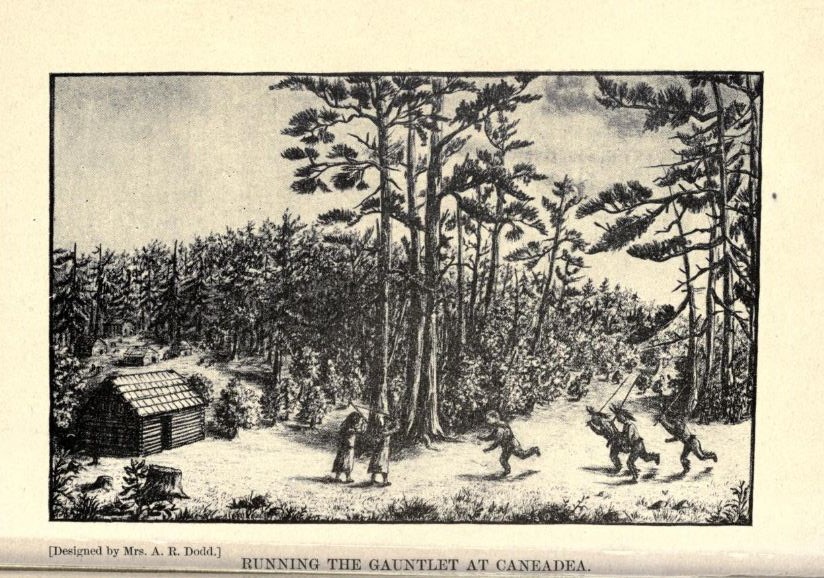
They flocked around him and patted him on the shoulder, exclaiming "Shenawana!" "Cajena!" "Brave man." "Good fellow," and at once he was the hero of the day.
Lieut. Nellis introduced him to his father, Capt. Nellis, commending him for his bravery, saying, “He fought me manfully, and if he had been equally manned, would have beaten me, but as my party was the strongest I overcame him. Since he has been a prisoner, has conducted himself like a gentleman, and I wish him treated like one.
The captain invited him to dine with him. He accepted and made the discovery that his wife was a dusky Seneca squaw.
The war dance and the turtle dance were gone through with. In the latter a beautiful young squaw was brought to Van Campen for a partner by a warrior.
Dancing and festivity were kept up for two or three days; then the party passed on with their prisoners to Fort Niagara, where they were surrendered to the commandant and the Indians received their pay.
Jones’ directions to “lie like the deuce and stick to it if quizzed as to Van Campen, ” had been carried out to the letter, and he had slipped through their hands undiscovered.
In a short time, however, they learned the facts. A fierce row ensued, and the demand was refused. They they offered to give fourteen other prisoners for him, but to no avail. The prisoners were soon on board ship for Montreal, from which place they were in due time exchanged.
1791 Col. Thomas Proctor made the journey from Philadelphia to Buffalo Creek to attend a council of western Indians.
Ga-o-za-de-o was on his route. The day he was here the town was nearly deserted, it being in the sugar making season.
He described the village as being "on a high bluff overlooking the Genesee river."
He spelled the name Canaseder. To quote: "In this place is erected a wooden statue or deity fashioned like a fierce looking sage. This form they worship by dancing before it on festive occasions or new moon."
The village then consisted of about 30 houses, some of them done in a manner that, shows some taste in the workmen.
In 1797, at the treaty of Big Tree, with the exception of a few reservations unimportant in extent, in the immediate vicinity of their principal villages, the Senecas parted with their western New York lands to Robert Morris.
Of the six reservations on this river, five were made of two square miles each, while Ga-o-za-de-o was laid off eight miles long by two wide, or six square miles larger than all the others together. I have always considered this circumstance a fair measure of the relative Importance of the several reservations.
And yet this great difference in size may may have been, In part at least, owing to the superior influence, tact and diplomacy of the Caneadea chiefs, who at first made claim for a tract 50 miles long by six wide.
In September, 1798, Augustus Porter ran the boundary lines. Who of the local Indians accompanied him, (for it was left to them to say where the tract should be laid), I have never learned.
Doubtless, though, the two irrepressible leaders, Shongo and Hudson, were on the ground, and if Red Jacket did not show up, it would be contrary to his practice for to use a homely expression, "his nose was stuck into" every land deal, as well as any other matter of importance to the Senecas.
The lines were found to include five villages, Wes-kaugh-ya, evidently Wlscoy; Sho-ne-ta-ye, old Can-a-du-dea, New Can-a-du-dea, and Capt. Shongo's.
Old Can-a-du-dea was this place, and Shongo's must have been the little village or collection of huts which the late George Parker of hunting renown found when he "took up" the land now covered by the McClure and Bartlett farms, on the flats nearly opposite the station at Houghton's.
The flats were called Shongo's Plats, and the little stream which there emerges from the hills was, and still is, and long will be known as Shongo Brook.
And the famous old Indian sugar bush at the mouth of the brook was, I think, called Shongo's. Some who hear me can well remember that "bush." I do, very well.
This territory is admitted to be a delightful section now. What must it have been in early times, and under Indian domination.
The Genesee valley is said to have been the terrestial paradise of the Senecas. It really filled all the requirements which a race of people like our American Indians could exact as the conditions of an ideal home.
The river languidly wound its tortuous course through broad open flats which responded generously to the rude cultivation of the Indian women, laughing with bounteous harvests of corn, beans, squash, anything indeed, which they chose to cultivate, when slightly tickled with their rude implements of husbandry. And anon, ran the silver ribbon the Ge-nish-he-o, through heavily timbered flats, bearing an enormous wealth of gigantic pines, gracefully spreading elms, and large, white buttonwoods, while the banks were fringed a good part of the way with butternut, elm, willows, a species of cottonwood and occasionally a fragrant balm of Gilead.
Enormous grape vines, climbing ivy and the beautiful bittersweet twined their tendrils about them, adding much beauty and attraction, while here and there on the bottom lands, were found groups of plum and thorn apple trees, and occasional small apple orchards, doubtless grown from seeds introduced by Jesuit missionaries. The uplands presented a great variety of timber and herbage in endless quantity.
Deer in great number roamed the grand old woods; bears not infrequently, and wolves, panthers and other wild animals abounded; while the streams were filled with fish of various kinds, the trout predominating.
If I were a Parkman, I could make you hear the sighing of the pines, the murmur of the rills, the laughter of the shallows, the roar of the waterfalls of old Ga-o-za-de-o, but I despair.
By running the lines, Ga-o-za-de-o was somewhat abbreviated in length, and in some places lessened in width, as originally it was supposed to include the Caneadea creek and gorge, and to extend as far north as Fort Hill.
When the war of 1812-14 came on, there was some anxiety on the part of the whites as to the probable attitude of the Caneadea Indians, as the part they took in the Revolution was well known.
Especially was this the case at Angelica. Accordingly, a committee was sent down here to confer with the chiefs and warriors, and ascertain, if possible, what they might expect as to their conduct during the unpleasantness.
A council was called and an aged chief, quite likely Hudson, addressed his people. Taking a little child in his arms, he compared it to the colonies in the Revolution, saying: "Child that he was then, he whipped the big man, Great Britain. Now child grown to be big man, too, what will he do?" He counseled friendly relations with his white neighbors.
The committee returned in the best of spirits, and In a few days a deputation of Caneadea Indians visited Angelica, and in the old court house a meeting was held, the Indians seated on one side, the whites on the other. The deliberations were closed with the impressive ceremony of smoking the pipe of peace; in which all took part.
Not only were the Caneadea Indians friendly, they were more than friendly.
At a council hold at Buffalo by Erastus Granger on the 25th of July, 1813, Capt. Shongo from Caneadea said: "That eleven men from their village intended to stay and fight, and would stay a month longer."
Cornplanter from Allegheny said: "We turn out seven." Sharp Shins from Etyakle Hill said "I will stay alone.”
Another measure of the importance of Ga-o-za-de-o. The Senecas did help the United States in that war and in doing so were found in arms, for the first time against their brothers, the Mohawks. Keepers of the eastern door, who after the Revolution removed to Caneadea, and continued their allegiance to Great Britain. It caused bad feeling between the Mohawks and Senecas. It was with difficulty that a Mohawk, Col. W. J. Simcoe Kerr, a grandson of the famous Capt. Brant, could be persuaded to attend the last council on the Genesee in 1872 on that account.
About 1800, settlement on all sides of this reservation became quite active, in some Instances the settlers' lands joining that of the Indians.
The settlers sometimes hired land of the Indians to plant with corn. Instances were known were Indian children attended the nearby district schools.
As a rule their relations with their white neighbors were pleasant. They kept up their customary feasts, dances and observances.
Many of the whites attended them, largely from curiosity and in some Instances made themselves offensive to the Indians. Especially was this the case at the ceremony of burning the white dog.
Indeed, it came in time that they much preferred that the whites stay away. In one instance the ceremony was deferred for a day on account of the presence of so many whites.
The late Loran Houghton informed me that he once attended a green corn dance at this place, when the attendance was so large as to require six five-pail brass kettles to boil the corn succotash and venison on which they feasted.
They came from Tonawanda, Allegheny, Cattaraugus and Buffalo.
Mrs. Philip Church was invited to attend one of their annual feasts and dances here. This was during the war of 1812 when her husband was in England.
She came with a daughter and a visiting friend, bringing a sleigh load of provisions, blankets, trinkets and ribbons in great variety, remained overnight, was given much attention and was adopted into Chief Shongo's family and given the name Ye-nun-ke-a-wa.
When the battle of Lake Erie was fought It has been said that the Caneadea Indians heard the guns, so acute was their sense of hearing. They at once sent a number of their braves to Belvidere, offerings to place a guard about the mansion, fearing, they said, I that the Canada Indians might make trouble. She declined the offer and got along very well without such attention. But after a while for obvious reasons, the Indians thought It best to sell their lands.
So on the 31st of August, 1826, at the council house on Buffalo Creek, after due deliberation, they conveyed this reservation, with some other lands, to a syndicate of land speculators, for the sum of $48,216.00. Among the names of the 47 grantors are found Shongo, Big Kettle, Red Jacket and Cornplanter.
In 1827, Joseph Jones, the Quaker surveyor, appeared on the scene and subdivided the tract into lots of suitable size for farms.
At that time the village consisted of only five houses and the council house and there were eleven apple trees. The Indians soon began to leave, and by 1830 scarce a red man was left on the reservation. The last to leave was Captain Shongo. He was loth to go, and his leaving was Indeed pathetic. No wonder is it.
Joel Seaton soon came into possession of this lot. He removed the council house to this place, and here, by the roadside, for many years, it stood, an object of much interest and curiosity to passersby.
During the sixties I made the acquaintance of Mr. William P. Letchworth, soon finding him much interested in anything relating to the Indian occupation of this valley.
I told him of this interesting old structure and what I could learn of It. He wanted to see it, and 37 years ago, about this time, he came to Hume, where I was then living, and together we visited the old Seneca council house here.
Still more careful Inquiry was made and satisfied as to its antiquity, identity and historic associations, he became much Interested. I have sometimes thought he was really infatuated with the idea of possessing it. Early in the fall of that year he commissioned me to purchase It for him.
I did so, marked all the timbers, looked carefully after taking it down and shipped It to him on the canal.
With his customary thoughtfulness, he came up with an artist, and a picture was made of it before any portion had been removed. Of late years, for some reason, Mr. Letchworth has come to regret the making of the picture, but I am very glad it was taken.
During the summer of 1872 it was with almost religious care, reconstructed under the personal supervision of John Shanks, an aged Caneadea Indian, who knew the building when he was a boy, and it was restored as nearly as possible to its original condition.
On the first day of August, 1872, it was rededicated, former President Fillmore gracing the occasion with his presence, and presiding over the ceremonies.
Directly after the dedicatlve ceremonies, the last Indian council on the Genesee was held in the old Ga-o-za-de-o council house, whose original site you have with so much propriety just marked.
After the routine proceedings were ended, Nicholson Parker, who made the opening speech, In a few words spoken in his own tongue, formally closed the council.
Then turning to the white guests he finished a short speech with these Impressive words: "The Ho-de-no-sau-nee, the people of the Long House are scattered hither and yon. Their league no longer exists, and you who are sitting here today have seen the last of the Confederated Iroquois.
"We have raked the ashes over our fire, and have closed the last council of our people in the valley of our fathers."
Letchworth, presented each of the invited Indian guests, a silver medal especially prepared as a souvenir of that interesting event.
A part of the dedication exercises was assigned to your humble servant. Duties of a nature quite unyielding, however, prevented his attendance, which he has ever regretted.
Through all the years since, Mr. Letchworth has watched with jealous eyes and carefully preserved the venerable old relic of our predecessors in this valley and wise provision has been made for its future.
There let it stand for aye, on that lofty eminence mid the wildest and grandest scenery of the Genesee, where thousands annually shall gaze upon the old walls, which here at old Ga-o-za-de-o, echoed the matchless eloquence of Red Jacket, and rang with the impassioned appeals of Hudson, a mute but eloquent and pathetic reminder of the proud people whose home was once this beautiful valley of the upper Ge-nish-he-o, whose capltol was old Ga-o-za-de-o.